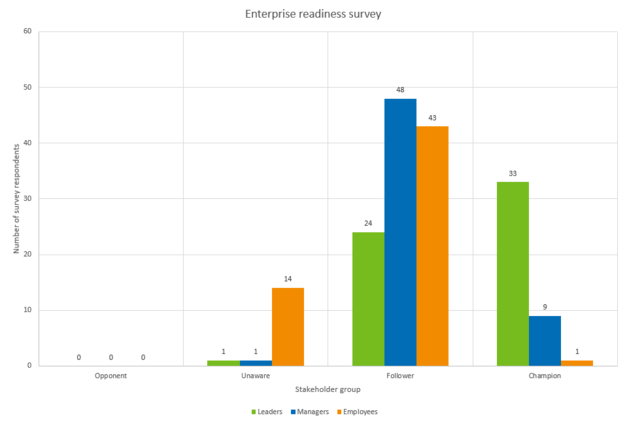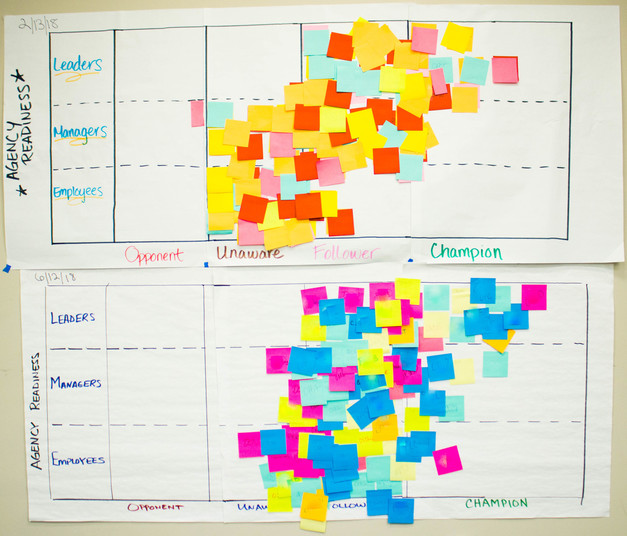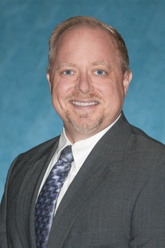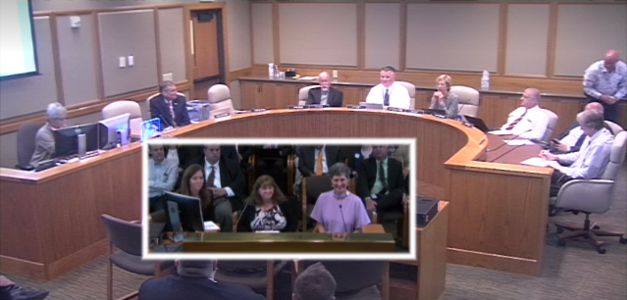|
September 2018 | Workday Project Newsletter

The results are in: We are prepared for Workday
By Anna King, Communications Coordinator, Workday Project
During the week of August 27, Agency
Readiness Contacts, Change
Leaders and HR directors completed the third round of the Workday Project’s
Enterprise Readiness Survey on behalf of their agencies. This survey
gauges the readiness level of three stakeholder groups across state government: agency executives (“leaders” in green), managers (in blue) and employees
(in orange). Survey respondents had four readiness levels to
choose from when categorizing each of these stakeholder groups: opponent;
unaware; follower; or champion of Workday implementation. “Champions” are Workday
implementation advocates and active supporters. “Followers” represent members
of state government who have the ability and willingness to learn and support Workday
implementation. Fifty-three percent of survey recipients completed the survey. Click on the following graphic if you would like to view a PDF version of the chart summarizing the survey responses.
 Bar chart of round three results of the Enterprise Readiness Survey
Survey results suggest most state government leaders are
champions whereas most managers and employees are followers. Employees represent the stakeholder group least familiar with the pending Workday
system. In addition to stakeholder readiness evaluation, survey respondents
were invited to provide feedback for the project team; Erin Haag (Executive Director,
Board of Examiners for Speech-language Pathology & Audiology) summarized
how many members of the enterprise feel in the wake of pushing back Workday go-live
twice this year: “We’re looking forward to [Workday] but glad [the team is]
taking time to get it right.” The first two Enterprise
Readiness Surveys, completed in February and June, show stakeholder groups steadily moving toward “champion.”
 Results of rounds one and two of the Enterprise Readiness Survey
The photo above captures the first two rounds of survey
responses, and readers are welcome to revisit the February
2018 edition of the Workday Project Newsletter for a deeper look at the
first round of the survey. The project team’s Organizational Change Management
unit continues to use Enterprise Readiness Survey results to help steer project
communications in preparation for the new Workday go-live date
announcement.
Please note that the
Enterprise Readiness Survey and Agency Readiness Assessment are two separate
surveys; the first Agency Readiness Assessment was distributed to agencies
through the Change Network during November 2017 and will be distributed
directly to all state government employees 30 to 60 days before Workday goes live.
 From the inside in: Steering committee interview with Brian Deforest
By Karsyn Mathany, Project Administrative Support, Workday Project
What are the primary project messages and
communications methods you want to see delivered to your managers? To staff in
general?
My number one priority is that payroll is accurate and on
time. As such, I want to make sure that staff, who are accustomed to “green
screen” technology, are comfortable with the fact that this new system will be
on our handheld devices and available to them like never before.
What is the biggest challenge your agency is
facing as a result of the project?
I think that the biggest challenge DAS* is currently
facing with regard to the Workday Project is trying to manage processes and
cultural changes around personnel and payroll. We have to consider whether to
change statewide policy or not; DAS has to consider whether to make blanket
changes for the entire enterprise. We also must ask ourselves, “What are the lessons
learned from this project that we can apply to the payroll/timekeeping project
in two years?” It is important for us to consider mistakes and successes from previous
projects to make progress on future projects.
We learned a lot during the implementation of the Statewide
Financial Management Application (SFMA) and the Oregon Budget Information
Tracking System (ORBITS). For example, procedures should be less agency-specific
and more enterprise-focused. We learned that agencies gravitate toward more
concrete policy lines. People want to know where the boundaries are, and
there needs to be balance – no boundaries is bad, and too many boundaries is
bad. I would argue that this project is the completion of (or the next step of)
SFMA, not the beginning of a separate, new journey. It is only a matter of time
before other systems will need to be replaced; this is just a part of the
process to keep things as efficient as possible.
What is the biggest challenge you see the
project team facing right now?
The project team’s biggest challenge is striking
a balance between training people too early versus too late. Personally, I am
not sure when the right time to start training actually is, but at the very
least, people want to know when training will start in order to mentally
prepare themselves for learning the new system. Fortunately, the steering committee for this project is one of the most balanced committees I have ever been a part of; the agency sizes and functional areas represented are very diverse. The executive leadership
team and Katy’s** participation have had a great hand in this project, helping
round out its overall guidance.
Do you have any advice for the project team?
My advice for the project team is to continue listening. In
terms of making sure that our new system works, you can’t solve every
conceivable problem with it, but it can certainly deliver on outperforming the
legacy HR systems we have now. The transition to Workday won’t be perfect on day one, but the product will adapt to our future needs and will get better every
day. Looking back on previous projects, SFMA most directly affected the
accountants and reporting professionals, and ORBITS affected the budgeteers and
the Legislature; but this project affects all employees and the upcoming
payroll/timekeeping project will affect all employees on an even more personal
level. This is why we need to make sure the Workday Project is as successful as it can
be.
*Department of Administrative Services
**Katy Coba, Chief Operating Officer and Department of
Administrative Services Director
|
Recap: Project sponsors give JLCIMT presentation
By Joyce Martinez, Project Manager, Workday Project
On September 25, Katy Coba (Chief Operating Officer and Department
of Administrative Services Director) introduced the project’s sponsors (Madilyn
Zike, Chief Human Resources Officer, and Lisa Sumption, Director, Oregon Parks
and Recreation Department) before the Joint Legislative Committee on
Information Management and Technology (JLCIMT). Although they were slated for an approximately 15-minute presentation and Q&A session, time constraints limited the presentation. As such, Madilyn and Katy provided a
higher level synopsis of project efforts thus far. Included in the "DAS - HRIS Report" PowerPoint (available under the published "Meeting Materials") is a much deeper dive in to the project's current status.
The PowerPoint summarizes completed
go-live preparation activities and milestones spanning August 2017
through May 2018. The capstone of the slide deck is
a status update on the interface testing between state government's legacy systems and Workday. The following slide captures action items during the current testing
phase surrounding the release of Workday 31, the version of Workday state
government will implement at go-live. Green check marks designate completed
tests, blue arrows indicate items that need to be completed before
implementation, and grey check boxes specify items in process and those that need to be completed after
testing is done and the enterprise prepares for the go-live stage of the
project. (Click on the slide for a PDF version.)
 "Activities for Implementation" slide for the project sponsors' JLCIMT presentation
The interface of the legacy payroll system and Workday is the project team’s highest
priority interface (read the August
2018 edition of our newsletter for more information).
Click on the screenshot of Katy, Madilyn and Lisa’s JLCIMT presentation below to watch their entire 6-minute presentation.
 Screenshot of the recorded JLCIMT presentation
Hyperlinks
Agency Readiness Contacts: https://www.oregon.gov/das/HR/Documents/Workday%20-%20agency%20readiness%20contacts.pdf
August 2018 edition of the Workday Project Newsletter: https://content.govdelivery.com/accounts/ORDAS/bulletins/20668bd
Blog: https://workdayoregon.blog/
Change Leaders: https://www.oregon.gov/das/HR/Documents/Workday%20Project%20-%20contacts%20by%20program%20area.pdf
Enterprise Readiness Survey III results: https://www.oregon.gov/das/HR/Documents/Workday%20Project%20-%20Enterprise%20readiness%20survey%20III%20responses%20bar%20graph.pdf
February 2018 edition of the Workday Project Newsletter: https://content.govdelivery.com/accounts/ORDAS/bulletins/1de389c
JLCIMT - Activities for implementation: https://www.oregon.gov/das/HR/Documents/Workday%20Project%20-%20JLCIMT%20presentation%20slide%20-%209.25.18.pdf
JLCIMT informational meeting recording: http://oregon.granicus.com/MediaPlayer.php?clip_id=25155
JLCIMT meeting materials: https://olis.leg.state.or.us/liz/2017I1/Committees/JLCIMT/2018-09-25-12-00/MeetingMaterials
Twitter: https://twitter.com/workdayoregon
Website: https://www.oregon.gov/das/HR/pages/workday.aspx
For more information about the project, please visit our website. Stay informed by following our Twitter feed and blog!
|










